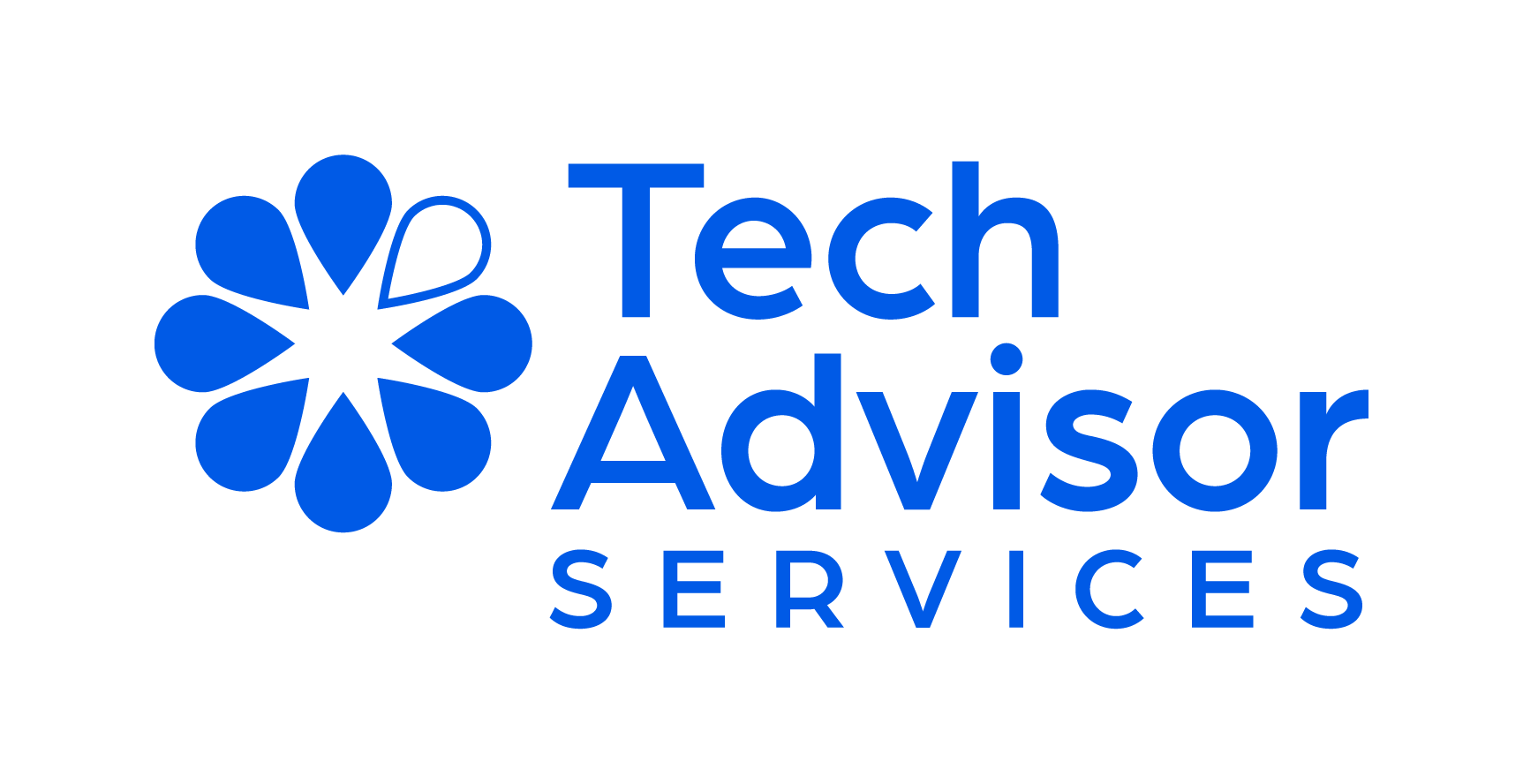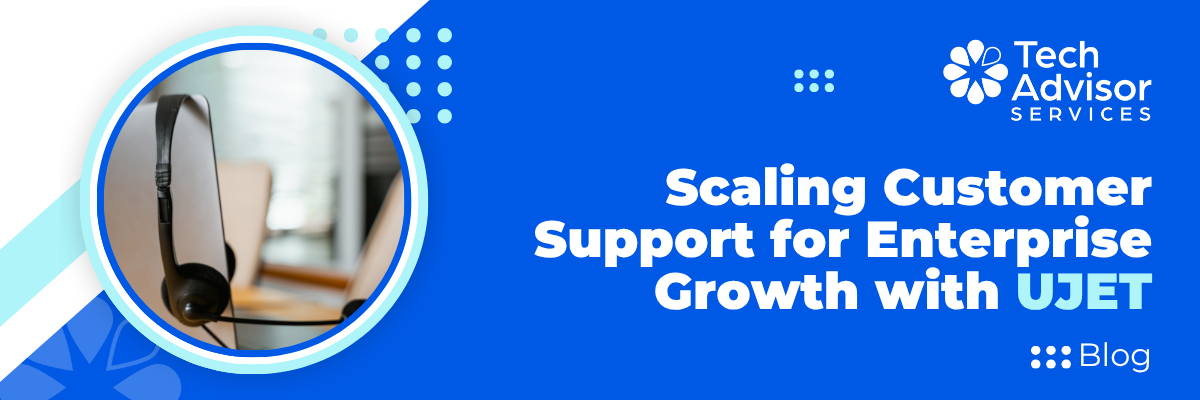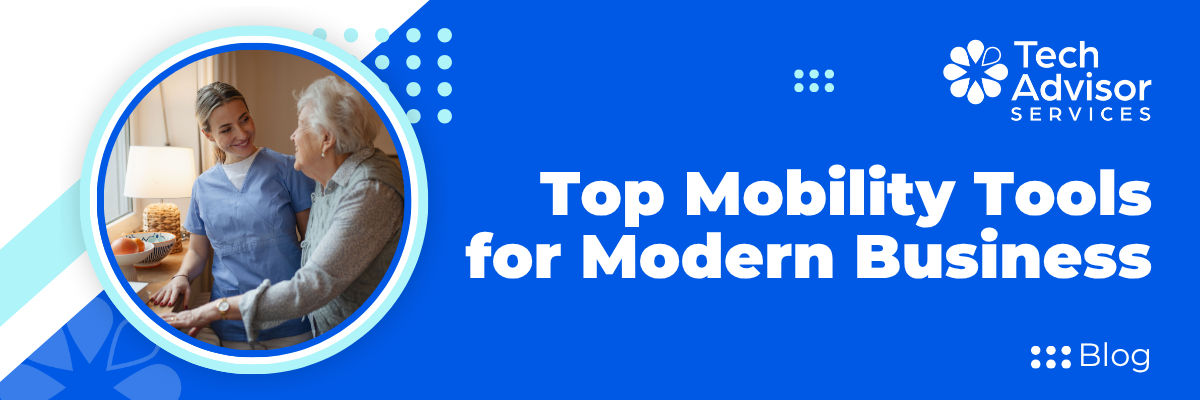Blog.
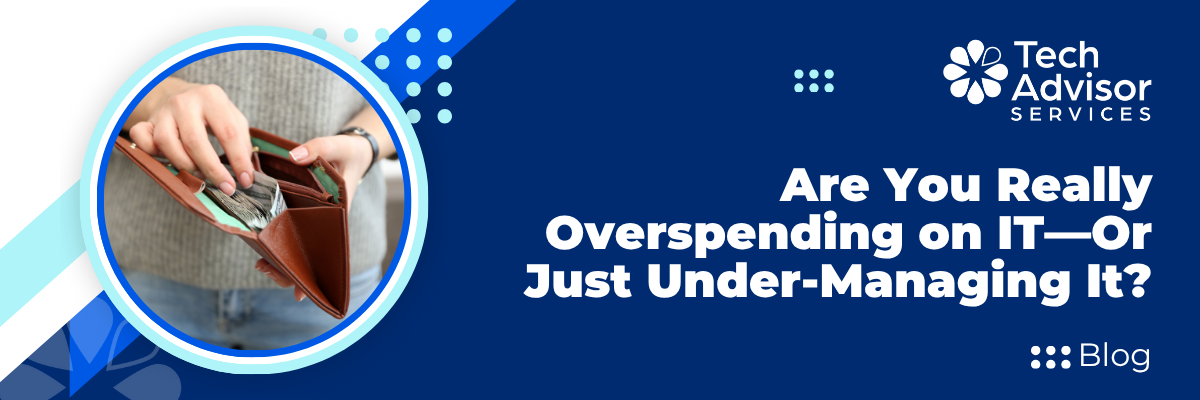
Are You Really Overspending on IT—Or Just Under-Managing It? If your IT budget feels like it’s growing faster than you can track it, you’re not alone. According to West Monroe’s State of B2B Software & AI Spend report, 86% of U.S. companies increased IT spending in the past 12 months, and 85% expect to do so again next year ( Journal of Accountancy , 2025). Yet nearly two-thirds (63%) of executives believe they spend more than their peers ( West Monroe , 2025). That misperception often triggers defensive, short-term cost-cutting rather than strategic optimization. As the Journal of Accountancy article notes, “When organizations think they’re overspending relative to competitors, they become defensive rather than strategic, and cost-cutting becomes the primary priority.” Most organizations now dedicate 7% or more of total revenue to IT ( West Monroe , 2025). And while cost pressures remain high, the drivers of spend are shifting rapidly. Artificial intelligence (AI) tops the list: 23% of IT budgets are already allocated to AI initiatives, and 91% of leaders expect AI to increase overall tech spend in the coming year—including 47% who anticipate a “significant” increase ( West Monroe , 2025). In fact, 42% of respondents selected “scaling AI and data capabilities” as their top investment priority— twice as popular as “improving cybersecurity and risk resilience” ( West Monroe , 2025). AI isn’t replacing people—it’s expanding capacity. While 25% expect AI initiatives to significantly increase headcount , just 1% expect them to significantly decrease it ( West Monroe , 2025). That’s a strong signal that organizations see AI as an accelerator, not a cost reducer. At Tech Advisor Services, we see a consistent pattern: companies are spending more on technology but managing it with limited visibility. Multiple vendors, auto-renewed contracts, and siloed purchasing make it difficult to distinguish what’s strategic from what’s simply habitual. When organizations benchmark pricing, normalize contract terms, and centralize oversight, they often uncover 15–25% waste from duplicate SaaS licenses , 20–30% overpayment in telecom contracts , and cloud infrastructure costs that have quietly doubled over time (TAS benchmark data). These aren’t overspending problems—they’re oversight problems. To shift from reactive to strategic, start with three simple steps. First, benchmark the market —compare your spend and contract terms to verified data, not gut feel. Second, tie spend to outcomes —every category, from connectivity to AI, should map to measurable value. Third, centralize vendor management —bring contracts and renewals under one governance process for better forecasting and leverage. Most companies aren’t truly overspending on IT—they’re under-managing it. As budgets rise, visibility and accountability must rise with them. If you’re unsure how your technology spend compares to peers—or how to align it with measurable outcomes—Tech Advisor Services can help you make sense of the numbers and get more from every dollar invested. Because the question isn’t how much you’re spending. It’s how much you’re getting back. References: Journal of Accountancy (2025, Oct 2). Is spending on technology spinning out of control? West Monroe (2025). The State of B2B Software & AI Spend.
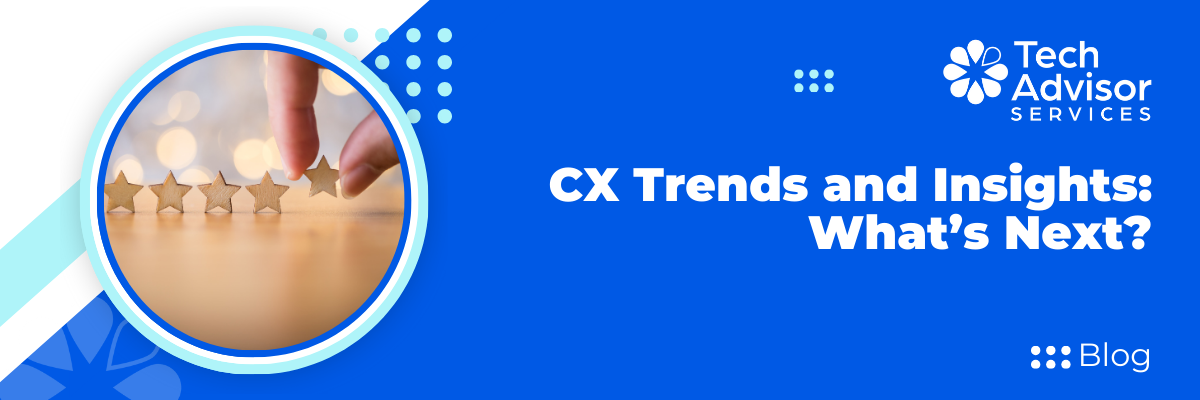
Blog- CX Trends and Insights: What’s Next? Customer experience (CX) has never been a one-and-done strategy. It evolves as quickly as customer expectations, workplace habits, and technology itself. The businesses that thrive are the ones that adapt their CX approach to reflect where people are heading, not where they’ve been. As 2026 approaches, companies are rethinking what it means to deliver value at every touchpoint. CX isn’t just about keeping customers satisfied; it’s about creating connected, personalized experiences that drive loyalty, reduce churn, and unlock long-term growth. Technology is the critical link, and the right solutions make it possible to scale customer-first strategies in a sustainable way. So what’s next in CX? Let’s look at the key trends and insights shaping the year ahead. 1. AI Moves From “Nice to Have” to Business Critical Artificial intelligence in CX is no longer experimental, it’s becoming foundational. Businesses have shifted from testing AI in isolated use cases to embedding it across the customer journey. We’re seeing AI power: Smarter self-service through natural language processing that understands intent and delivers accurate answers. Agent assistance that reduces handling times by surfacing next best actions in real time. Predictive analytics that forecast churn, upsell opportunities, or service demand before it happens. The value is clear: customers get faster, more relevant support, while businesses reduce costs and improve efficiency. The challenge for 2026 is choosing platforms that balance automation with the human touch. Too much automation without empathy risks alienating customers. The sweet spot is blending AI with live agents who can step in when conversations require judgment, reassurance, or creativity. 2. Omnichannel Is the Default Customers expect to move seamlessly from web to phone to chat to social and they don’t want to repeat themselves at every stop. In 2026, the idea of “omnichannel” isn’t innovative anymore; it’s table stakes. The new focus is on orchestration. It’s not enough to offer multiple channels, you need to connect them so context follows the customer. If someone starts a return online and calls your contact center later, the agent should instantly see the prior interaction and move things forward without friction. Technologies like cloud-based contact centers (CCaaS) and unified communications (UCaaS) are converging to make this possible. By housing conversations in one platform, businesses can finally give both customers and employees the connected experiences they’ve been promised for years. 3. Personalization Gets Real For years, personalization meant adding someone’s name to an email. Customers have grown beyond that, and in 2026, they expect businesses to know who they are, what they value, and how they prefer to interact. Personalization is shifting toward: Behavioral insights —serving offers, reminders, or help based on actions, not assumptions. Customer journey mapping that tracks the end-to-end relationship rather than isolated transactions. Dynamic experiences that adjust in real time, whether that’s a self-service portal that adapts to user behavior or proactive support triggered by device telemetry. CX platforms now offer the ability to unify data across CRMs, marketing automation tools, and contact center systems, giving organizations a 360-degree view of their customers. The payoff: stronger loyalty and more revenue per customer. 4. Employee Experience Becomes CX Strategy It’s impossible to deliver a great customer experience if your employees are struggling with outdated tools, complex processes, or siloed systems. Companies are realizing that employee experience (EX) and CX are two sides of the same coin. In 2026, investments in CX are increasingly investments in the workforce: Intuitive agent desktops that reduce clicks and manual work. Knowledge bases with AI search that empower employees to help customers faster. Flexible work solutions that let employees deliver great service whether they’re in the office, remote, or hybrid. The result is lower turnover, faster onboarding, and agents who are more focused on the customer than on wrestling with technology. 5. Digital Trust and Security Take Center Stage Customers are becoming more conscious of how their data is used. At the same time, businesses face growing risks from cyberattacks, fraud, and regulatory requirements. CX technology in 2026 must do more than serve customers, it must protect their trust. Expect to see: Stronger authentication methods that balance security with convenience, such as biometrics or frictionless multi-factor verification. Data minimization strategies that limit how much personal information is collected and stored. Transparent policies that tell customers exactly how their data is used and protected. Security isn’t just an IT issue anymore; it’s a customer experience issue. A data breach can undo years of trust in a single incident. 6. Proactive Service Reduces Friction Customers don’t want to contact support, they want problems solved before they happen. Proactive service is one of the fastest-growing trends for 2026. Examples include: Airlines sending automatic rebooking options before passengers call. Subscription services alerting customers to expiring cards before billing fails. IoT devices flagging maintenance needs before equipment breaks down. The technology behind this shift combines AI, data integration, and automation. When done well, proactive service not only reduces inbound call volume but also strengthens brand perception by showing customers that the business is looking out for them. 7. The Rise of Total Experience Gartner coined the term “Total Experience” (TX) to describe the convergence of CX, EX, user experience (UX), and multi-experience (MX). The idea is simple: if you improve experiences for everyone—customers, employees, and users—you create exponential business value. In 2026, more organizations are adopting TX strategies to break down silos. Rather than running separate initiatives for customer and employee engagement, they’re aligning technology and culture around a single goal: frictionless experiences across the board. For many, this means consolidating platforms to reduce complexity and create consistency. A single platform for communications, workflows, and data can fuel better collaboration and better service, no matter who’s on the other end of the interaction. 8. Measuring What Matters CX success has long been measured by metrics like Net Promoter Score (NPS) or Customer Satisfaction (CSAT). These remain useful, but businesses are realizing they don’t tell the whole story. In 2026, the focus shifts toward outcome-based metrics. For example: How does CX impact revenue growth? How does it reduce churn? How does it improve employee productivity or lower service costs? Advanced analytics now make it possible to connect CX performance directly to business results. This allows leaders to justify investments in CX technology with hard numbers and align initiatives with broader organizational goals. 9. The Value of Partnering for CX With so many moving parts—AI, omnichannel platforms, analytics, security—no organization can master CX transformation alone. That’s why advisory partnerships are becoming more valuable. Working with an independent technology advisor gives businesses: A clear view of the vendor landscape. Help negotiating contracts that balance cost with flexibility. Guidance on implementation and ongoing optimization. The CX market is crowded, and decision-makers need unbiased insight to select solutions that align with their strategy and budget. What This Means for 2026 The story of CX in 2026 isn’t just about technology. It’s about using the right tools to create meaningful, human connections at scale. Customers will continue to raise the bar for speed, personalization, and trust, while employees will expect tools that make their jobs easier and more fulfilling. Businesses that embrace these trends will move past reactive service and toward transformative experiences —the kind that create loyalty, advocacy, and long-term growth. The takeaway is simple: CX is the competitive advantage. Reinforcing the value of your CX technologies now will position you to meet customers where they are and where they’re going in 2026 and beyond. Ready to Reimagine CX? Tech Advisor Services helps organizations evaluate, source, and implement the right CX technologies, from CCaaS and UCaaS to AI-driven analytics and workforce tools. If you’re looking to reimagine customer experience for 2025, we can help you build a strategy that’s as practical as it is future-focused.
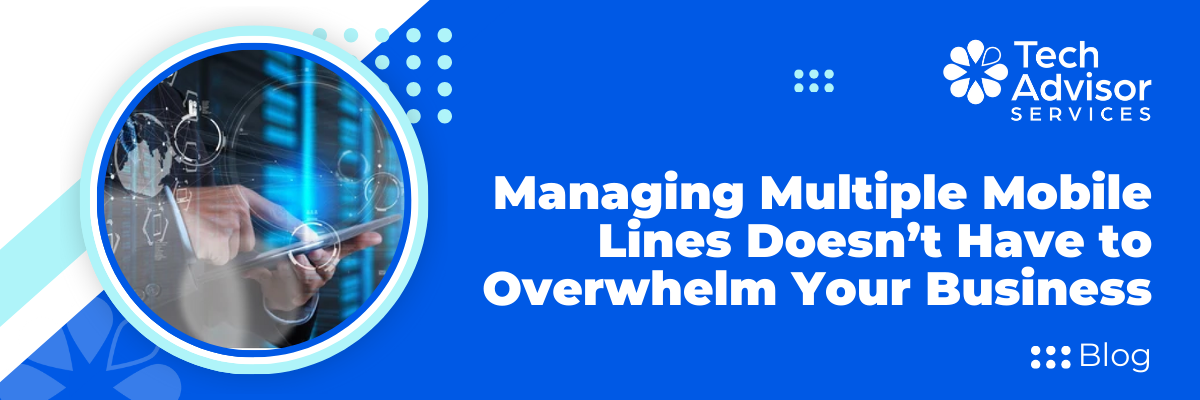
Managing Multiple Mobile Lines Doesn’t Have to Overwhelm Your Business For many growing companies, mobile devices are a lifeline. Field crews rely on them to stay connected with the office. Sales teams use them to manage deals on the go. Managers depend on them to coordinate across sites. But as your team expands, so does the complexity of keeping everyone connected. What started as a few company-issued phones can turn into a maze of mismatched plans, inconsistent billing cycles, and unused services that quietly drain your budget. At Tech Advisor Services, we work with trusted supplier partners like PureTalk Business to help businesses regain control of their mobility strategy. The right plan structure, combined with ongoing management, can save thousands every year — and eliminate the stress that comes with overseeing dozens or even hundreds of lines. Here’s how we help clients simplify the process and keep teams connected without the headaches. How Mobile Plans Get Complicated In many companies, mobile lines are added one at a time, without much strategy. An employee needs a phone, so one is added. Later, another hire gets a different plan. Over time, this leads to: Inconsistent plans and pricing – Employees are on different plan tiers, with different features and costs. Wasted data – Some users barely touch their monthly allotment, while others rack up overages. Billing complexity – Multiple accounts, providers, or payment cycles to track. Time drain – Hours spent reconciling invoices and tracking down unused lines. This approach works when you have three or four lines. Once you’re managing dozens, the inefficiencies pile up. Costs go up. Visibility goes down. And your IT or accounting teams spend more time on mobile administration than they should. Shared Data Pools – Better Use of What You Pay For One of the fastest ways to eliminate waste is by moving to a shared data pool. Instead of assigning each device a fixed amount of data, your team draws from one combined pool. This means a light user’s unused data can offset the heavy usage of a field tech running a hotspot or streaming training videos. Benefits of pooling your data: Balances usage – No more overages for one user while another wastes data. Reduces waste – Pay for what your team uses in total, not arbitrary chunks. Simplifies scaling – Adding or removing lines doesn’t require a plan overhaul. Example: We worked with a regional service company that had 45 lines across three states. Before pooling, they were paying hundreds in overage fees each month. After switching to a shared pool, those charges disappeared and their annual savings topped $18,000. Through PureTalk Business, we can deliver flexible pooled data options with reliable nationwide coverage, customized to how your teams actually use their devices. Centralized Billing – One Statement, Clear Visibility If you’re managing separate bills for multiple offices, departments, or locations, you know how quickly things get messy. Centralized billing brings everything into one consolidated invoice, with clear reporting for every line. Why it matters: Time savings – Accounting reconciles one bill instead of chasing dozens. Clear visibility – Detailed breakdowns make it easy to assign costs to the right location or department. Predictable payments – One due date makes budgeting and cash flow easier. Example: A multi-location retailer came to us with 60 separate accounts, one per store. The invoices arrived on different days, each with its own login. After moving to a centralized billing structure, their accounting time dropped by more than 75%, and they uncovered several inactive lines they were still paying for. Fleet Management – Letting the Experts Handle It Even with pooled data and centralized billing in place, managing the actual devices ordering, configuring, replacing, and troubleshooting can still eat up time and resources. That’s why Tech Advisor Services offers full mobile fleet management as part of our mobility solutions. We handle: Plan reviews – Regular audits to keep your costs in check. Device procurement – Ordering and shipping devices directly to users, ready to go. Lifecycle tracking – Monitoring each device from activation to retirement. Support escalation – Acting as your single point of contact with the carrier, so your team doesn’t waste time on hold. Vendor flexibility – We’re not tied to one provider, so we can design a multi-carrier approach if that’s what your coverage needs demand. With PureTalk Business as a supplier, we can pair cost-effective plans and strong coverage with hands-on management that keeps your mobility strategy running smoothly. Multi-Location? We’ve Got You Covered Coverage and costs can vary widely depending on where your teams work. A single-carrier plan might leave some locations with subpar service or cost more than it should in certain regions. We can mix carriers under one managed solution, ensuring each location gets the best possible coverage without giving up the benefits of pooled data and centralized billing. The Cost of Doing Nothing If your mobile setup isn’t reviewed regularly, inefficiencies creep in fast. You may be: Paying for unused lines. Overpaying for features your team doesn’t use. Getting hit with overages every month. The real cost isn’t just on the invoice, it's the staff time spent managing the chaos and the lost productivity when employees can’t connect reliably. The Payoff of a Smarter Approach When you consolidate, optimize, and outsource the management of your mobile lines, you: Lower costs by cutting waste and eliminating overages. Simplify operations with one bill and one point of contact. Improve coverage with plans built around your actual needs. Free up your team to focus on work that drives revenue, not phone bills. How to Start Simplifying If you’re ready to get mobile management under control, here’s where to start: Take inventory – List all devices, plans, and current usage. Identify waste – Look for unused lines, underutilized data, and duplicate features. Move to pooled data – Ensure your total usage is covered without waste. Centralize billing – Reduce admin time and improve visibility. Work with an advisor – Partner with a team that can manage the details for you. Why Tech Advisor Services We’ve helped businesses in industries from construction to healthcare to retail cut mobile costs and simplify management — often recovering tens of thousands in the first year alone. By partnering with PureTalk Business, we bring together: Nationwide coverage Flexible plan structures Competitive rates … and combine it with our hands-on management and vendor-neutral approach. You get the best of both worlds: the buying power and coverage of a leading provider, plus the strategic oversight of a dedicated technology advisor. Final Thought: Managing multiple mobile lines doesn’t have to be an ongoing headache. With the right structure, tools, and partner, it can be simple, predictable, and cost-effective. Let’s talk about how Tech Advisor Services can streamline your mobility strategy.
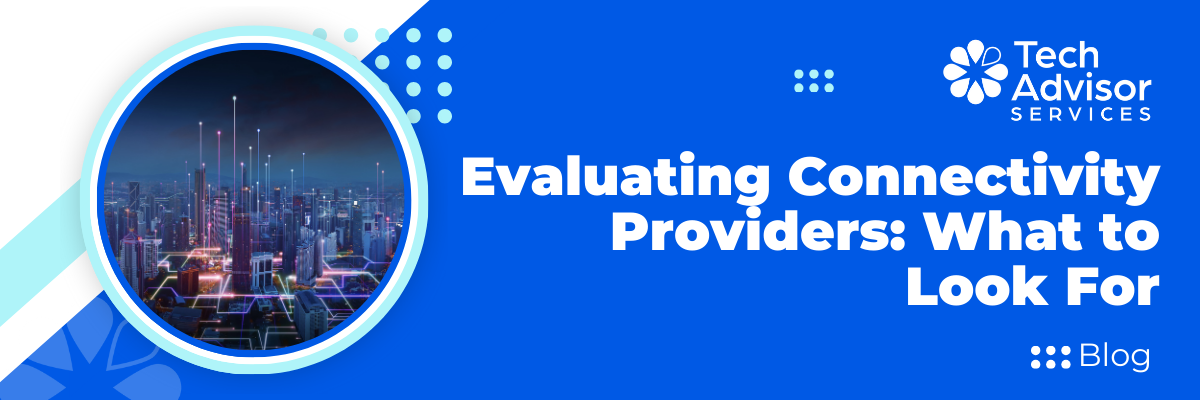
Evaluating Connectivity Providers: What to Look For When it comes to keeping your business connected, not all providers are created equal. Whether you're running cloud-based applications, enabling hybrid work, or just trying to ensure smooth day-to-day operations, your connectivity partner plays a critical role in how reliably and efficiently your business runs. But evaluating providers isn’t just about price. It’s about understanding how their infrastructure, support, and service models stack up against your business needs—today and in the future. In this article, we’ll walk you through the key factors to consider when evaluating connectivity providers so you can make smart, informed decisions that support performance, scalability, and uptime. Why Connectivity Matters More Than Ever Connectivity is no longer just a utility—it’s a strategic advantage. With distributed teams, real-time collaboration tools, cloud-first apps, and customer-facing digital services, your network has to be both reliable and high-performing to keep things moving. One glitchy connection or unexpected outage can cost more than just time—it can cost business. If you're considering switching providers or assessing your current setup, this is your opportunity to strengthen one of the most foundational parts of your IT stack. Key Considerations When Evaluating Connectivity Providers Let’s dig into what really matters. 1. Network Reliability and Uptime Guarantees Every provider talks about uptime—but how do you cut through the noise? Look for: SLAs (Service Level Agreements): Do they guarantee 99.9%, 99.99%, or 99.999% uptime? That extra decimal point can mean minutes vs. seconds of downtime. Network Redundancy: Do they offer multiple fiber routes or failover options? Redundant paths reduce the risk of a single point of failure. Proactive Monitoring: Is their network actively monitored 24/7? Are you alerted before your team notices an issue? A reliable provider should have nothing to hide when it comes to uptime stats and infrastructure design. 2. Geographic Coverage and Last-Mile Access Many businesses overlook the importance of last-mile connectivity—that final stretch from the provider’s network to your building. Here’s what to ask: Do they own their last-mile infrastructure, or do they lease it from others? Is fiber available to your location, or will it be delivered over copper or fixed wireless? If you have multiple sites, can the provider service them all, or will you be juggling multiple contracts? A strong provider should offer clean, end-to-end control or have a clear partnership model to deliver last-mile reliability wherever you are. 3. Bandwidth and Performance Flexibility Not every office or location needs the same bandwidth. And your needs today might not match your needs next quarter. Make sure the provider can: Scale your bandwidth up or down without major delays or fees. Offer bursting capabilities if you have high-traffic periods. Support QoS (Quality of Service) if you’re running VoIP, video, or latency-sensitive apps. You want flexibility without penalty. That means avoiding providers who lock you into fixed, long-term bandwidth tiers with high overage charges. 4. Security Features and Network Segmentation A good connectivity provider doesn’t just offer transport—it offers protection. Evaluate their: DDoS protection as part of standard service Private networking options (e.g., MPLS, private fiber) Built-in firewalls or security partnerships Ability to integrate with SASE or SD-WAN solutions Security should be baked into the network—not something you have to bolt on later. 5. Support and Responsiveness When something goes wrong, how fast can you reach someone who can help? Ask: Is support 24/7, or just business hours? Do you get a direct account manager or a generic ticketing system? What’s their average response time—and how is escalation handled? Don’t wait until an outage to find out if your provider takes support seriously. Choose one that treats your business like a partner, not a number. 6. Contract Flexibility and Pricing Transparency Lengthy contracts, surprise fees, and early termination penalties can turn a great-looking deal into a nightmare. When reviewing terms: Look for month-to-month or 1-year options if you're in a growth phase. Be cautious of "teaser" pricing that jumps after year one. Clarify what's included—installation, hardware, monitoring, service calls—and what's not. You want a provider who’s confident enough in their service that they don’t need to trap you in a 3-year commitment to keep your business. 7. Integration With Other Services Today’s IT leaders are thinking about connectivity as part of a larger stack —not a siloed decision. Ask about: Support for SD-WAN , cloud direct connect , or private peering How they integrate with your existing voice or UCaaS solutions Ability to bundle managed Wi-Fi , security , or failover services Providers that work well within a broader ecosystem will save you time, money, and frustration down the road. Bonus: Don’t Overlook the Power of Provider Aggregation One of the smartest moves mid-sized and enterprise organizations are making today is working with a connectivity consultant or aggregator —like Tech Advisor Services. Why? Because aggregators: Help you compare providers side-by-side Offer access to exclusive pricing not always available direct Can design hybrid networks using multiple carriers for redundancy Provide single-pane billing and ongoing account management In other words, you get options, leverage, and someone in your corner who understands both the technology and the fine print. Final Thoughts: Build for Now and What’s Next Choosing the right connectivity provider is about more than speeds and feeds. It’s about creating a foundation your business can build on. As applications get more cloud-heavy, as employees work from anywhere, and as security threats grow more complex, the network connecting it all becomes a critical part of your business strategy—not just your IT plan. Taking the time to evaluate providers across performance, support, flexibility, and integration isn’t just smart—it’s necessary. How Tech Advisor Services Can Help At Tech Advisor Services, we work with dozens of vetted, top-tier connectivity providers across the country—and help businesses design the right-fit solution for their unique needs. We’re vendor-neutral, which means we don’t push one provider over another. Instead, we focus on helping you: Compare carriers side-by-side Build for resiliency, performance, and future growth Reduce complexity with centralized sourcing and support Need help evaluating your current network or planning your next move? Let’s talk .
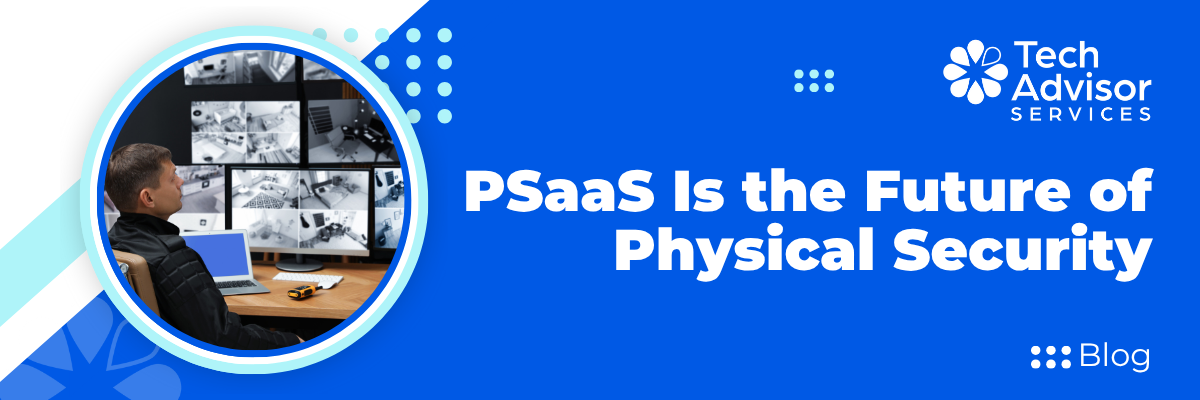
If you’re responsible for physical security, whether you are securing a handful of retail stores, a vast network of warehouses, or critical infrastructure, the traditional model of buying and managing security hardware is starting to seem a little dated in today's digital world. Just like software, voice, and network services have shifted into the cloud, physical security is undergoing its own digital transformation. The term Physical Security as a Service (PSaaS) is popping up everywhere and for good reason. Suppliers like Epic.io and YourSix are proving that PSaaS isn’t just another buzzword set of letters, but It’s a smarter, more cost-effective way to protect facilities, assets, and people. PSaaS is actually shaping up to be the future of physical security. Let’s see why. Traditional Physical Security: Clunky and Costly Historically, physical security systems have been a patchwork of: On-premise NVRs and DVRs Analog or IP cameras wired into fixed storage appliances Proprietary software requiring on-site servers Complex integrations between alarms, access control, and video systems All of this meant big upfront costs, ongoing maintenance headaches, and the constant risk of technology obsolescence. Hardware refresh cycles: Every 5-7 years, businesses faced expensive upgrades. Limited scalability: Growing your footprint meant buying more hardware and licenses. Siloed systems: Video, alarms, and access control often operated independently, leaving gaps in response. This model doesn’t mesh well with modern business needs, where agility, remote work, and real-time insights have become standard expectations. Enter PSaaS. What is Physical Security as a Service (PSaaS)? Physical Security as a Service flips the old model on its head. Instead of purchasing hardware and software outright, you “subscribe” to security services delivered from the cloud. PSaaS platforms like Epic.io and YourSix offer: Cloud-based video management Remote access and monitoring from any device AI-driven analytics for threat detection and operational insights Integrated alarm, access control, and video workflows Predictable monthly subscription pricing Think of PSaaS the way you think of UCaaS or CCaaS. It’s security, but as a scalable service instead of a collection of disparate hardware. Key Benefits of PSaaS Here’s why so many IT and security leaders are starting to put PSaaS on their roadmap: 1. Lower Upfront Costs One of the biggest hurdles to physical security upgrades has always been capital expenditure. New cameras, servers, and storage arrays require significant budget allocation. PSaaS changes that. Instead of capital outlay, costs are spread over a predictable monthly or annual subscription. Hardware is often included as part of the service or offered on a Hardware-as-a-Service (HaaS) model. This frees up capital for other strategic projects while keeping security infrastructure modern and up to date. 2. Scalability Without the Headache Opening new locations? Expanding operations? In the old world, you’d be planning: Hardware procurement Shipping logistics Local installation teams Server provisioning With PSaaS, adding cameras or integrating new sites can be as simple as shipping pre-configured devices and plugging them into power and internet. Platforms like YourSix can auto-configure cameras as they connect to the cloud. This makes PSaaS especially attractive for multi-site businesses that need consistent security policies across all locations. 3. Remote Management and Access Modern work environments are decentralized. Security teams can’t always be on-site—but threats can appear anytime, anywhere. With PSaaS: Security footage can be accessed from any device, anywhere in the world. Operators can view live video, review incidents, and share clips without physical access to local servers. IT teams can manage user permissions centrally. Epic.io, for example, enables real-time monitoring and video playback through a web portal, reducing the need for dedicated local infrastructure. This is a game-changer for businesses with distributed operations, remote teams, or limited on-site IT resources. 4. Advanced Analytics and AI Modern PSaaS platforms embed AI and machine learning tools that do much more than record video. Object recognition can differentiate between people, vehicles, animals, or objects left behind. Behavior analytics can detect loitering, tailgating, or perimeter breaches. License plate recognition (LPR) can automate gate access and logging. These capabilities turn video footage into actionable insights, helping businesses improve not just security, but also operational efficiency. YourSix, for example, integrates AI-driven analytics that can alert staff to suspicious behavior in real time—potentially preventing incidents rather than simply documenting them after the fact. 5. Enhanced Cybersecurity Old security systems are notorious for default passwords, outdated firmware, and vulnerable on-premise servers—prime targets for cyberattacks. PSaaS providers, on the other hand, build security into the core of their platforms: Data encrypted in transit and at rest Regular security patches deployed automatically No local servers vulnerable to physical tampering Granular user permissions and logging For organizations increasingly concerned about cybersecurity and regulatory compliance, this is a critical advantage. 6. Simplified Integrations Physical security used to mean separate silos for cameras, alarms, access control, and environmental sensors. PSaaS platforms unify these functions into a single ecosystem. Alarms trigger video bookmarks. Access events link to video snapshots. IoT sensors integrate with video analytics for comprehensive situational awareness. Epic.io’s PSaaS platform, for example, offers open APIs and integrations with existing business systems—like building management, logistics, or customer analytics platforms. This integrated approach means security becomes part of broader business intelligence, not just a standalone cost center. 7. Future-Proof Technology One of the biggest headaches with traditional security systems is technological obsolescence. By the time you finish deploying a new system, the tech may already be outdated. PSaaS providers continuously innovate: Rolling out new AI features Supporting higher-resolution video Enhancing cloud storage options Adding new integrations Because these upgrades are delivered through the cloud, businesses stay current without major rip-and-replace projects. Real-World Use Cases: Epic.io and YourSix Let’s look at how Epic.io and YourSix—two suppliers Tech Advisor Services often works with—are leading the PSaaS charge. Epic.io Epic.io has built a flexible PSaaS platform focused on delivering “Situational Awareness as a Service.” Their solution combines video surveillance, IoT data, and AI analytics into a single cloud-managed interface. Key strengths include: Cloud video management with secure, scalable storage IoT integrations for temperature, door sensors, and asset tracking Advanced AI analytics for real-time alerts Mobile access to live and recorded video feeds Open APIs for custom integrations Epic.io’s customers include critical infrastructure sites, logistics firms, and large retail chains looking to unify security across multiple locations. YourSix YourSix has made a name for itself as a pioneer in true cloud physical security. They offer a pure PSaaS model that includes both hardware and software in a subscription. Highlights: Plug-and-play cameras that auto-connect to the cloud AI-powered video analytics Centralized management of multi-site deployments Secure, cloud-based storage without local NVRs Integration with access control systems YourSix’s solutions have been deployed across retail, manufacturing, and logistics environments where rapid scalability and simplified management are mission-critical. Is PSaaS Right for Your Business? The reality is that PSaaS isn’t a fringe concept anymore—it’s becoming mainstream. And for many businesses, it’s the right choice. If any of these apply to your business, it’s time to explore PSaaS: You have multiple locations needing consistent security policies You’re tired of large capital expenditures and refresh cycles Your IT and security teams are stretched thin You want to leverage AI and analytics for proactive security Cybersecurity and compliance are high priorities You need remote access and centralized management PSaaS offers the flexibility, scalability, and intelligence that modern businesses expect—while often reducing total cost of ownership. Let’s Talk About Your Security Future At Tech Advisor Services, we help mid-market and enterprise clients navigate the shift to PSaaS. We work with leading suppliers like Epic.io and YourSix to design solutions that fit your unique environment, budget, and risk profile. Thinking about modernizing your physical security? Let’s have a conversation. We’ll help you compare suppliers, evaluate costs, and design a roadmap for the future of your security infrastructure.
